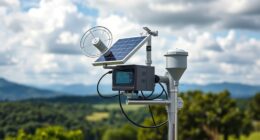To clean and descale your evaporative cooling pads, turn off the system and drain water to prevent spills. Carefully remove the pads and soak them in a mixture of mild detergent or a descaling solution for 15-30 minutes. Gently scrub dirt and mineral deposits using a soft brush, then rinse thoroughly with clean water. Using softened or filtered water can reduce future buildup. For detailed steps and tips, keep exploring the best maintenance practices for your system.
Key Takeaways
- Regularly inspect pads for mineral deposits, dirt, or residue before cleaning.
- Use a mild detergent solution for routine cleaning and soak pads for 15-30 minutes.
- Apply specialized descaling solutions to remove stubborn mineral buildup effectively.
- Rinse pads thoroughly with clean water to eliminate cleaning residues and prevent damage.
- Use softened or filtered water and maintain water treatment strategies to reduce mineral deposits and extend pad life.

Evaporative cooling pads are essential for maintaining efficient and effective cooling, but over time, mineral buildup and dirt can reduce their performance. Regular pad maintenance is crucial to ensuring your cooling system continues to operate at peak efficiency. When mineral deposits accumulate, they clog the pores of the pads, restricting airflow and decreasing water absorption, which leads to reduced cooling capacity. To prevent this, you need to stay on top of cleaning routines and incorporate proper water treatment methods.
Start by inspecting your pads regularly for signs of buildup, such as white crusty deposits or slimy residues. If you notice these issues, it’s time to plan a thorough cleaning. Before you begin, turn off the system and drain any remaining water to prevent spills. Remove the pads carefully, avoiding damage, and prepare a cleaning solution. A mixture of mild detergent and water often works well, but for stubborn mineral deposits, you might need a specialized descaling solution designed for evaporative pads. It’s important to follow manufacturer instructions to avoid damaging the material.
Inspect pads regularly; turn off system, drain water, and carefully clean with mild detergent or descaler.
Water treatment plays a critical role in minimizing mineral buildup. Using softened or filtered water can greatly reduce lime and mineral deposits that tend to form when hard water evaporates. If you’re using hard water, consider installing a water softener or a pretreatment system to lower mineral content, which helps prolong your pads’ lifespan and maintain their efficiency. Regularly checking your water quality and applying appropriate treatment not only reduces the frequency of cleaning but also prevents the formation of scale, which can be difficult to remove once set.
When cleaning, soak the pads in the prepared solution for about 15-30 minutes to loosen dirt and mineral deposits. Use a soft brush or cloth to gently scrub the surface, paying special attention to corners and folds where debris can accumulate. Rinse thoroughly with clean water to remove any residual cleaning agents or loosened deposits. Avoid using harsh brushes or abrasive cleaners, as they can damage the delicate material of the pads. Once the pads are clean and dry, reinstall them carefully, ensuring they’re properly seated to allow for unobstructed airflow.
Additionally, maintaining the air quality in your environment by regularly cleaning and treating your pads helps prevent mold and bacteria growth, which can affect indoor air health. Maintaining your evaporative cooling pads through regular cleaning and effective water treatment is an easy way to optimize system performance. By preventing mineral buildup and dirt accumulation, you’ll extend the lifespan of your pads, reduce energy costs, and keep your space cool and comfortable. Remember, proactive pad maintenance isn’t just about cleaning—it’s about implementing a comprehensive water treatment plan that supports your system’s health over time.
Frequently Asked Questions
How Often Should I Replace Evaporative Cooling Pads?
You should replace your evaporative cooling pads when they show clear replacement indicators, such as significant discoloration, mold, or damage. Generally, follow a maintenance schedule of inspecting them every 6 to 12 months, depending on usage and water quality. If you notice reduced cooling efficiency or persistent odors, it’s time for replacement. Regular checks help guarantee peak performance and prevent issues caused by worn or dirty pads.
Can I Use Chemical Cleaners on the Pads?
Think of your cooling pads as the heart of your system; using chemical cleaners on them is like giving it a harsh punch. You shouldn’t use strong chemical cleaners for pad maintenance, as they can damage the delicate material. Instead, opt for gentle cleaning solutions or descaling agents recommended by manufacturers. This keeps your pads functioning efficiently and prolongs their lifespan, ensuring your cooling system keeps you comfortably cool.
What Is the Best Way to Prevent Mold Growth?
To prevent mold growth on your evaporative cooling pads, guarantee proper air circulation around the pads by maintaining unobstructed airflow. Regularly inspect and clean the pads to remove dirt and moisture buildup, which foster mold. Keep the area dry and well-ventilated, especially during off-seasons. Using a mold-resistant treatment can also help. Consistent maintenance and good airflow are key to mold prevention and keeping your cooling system efficient.
Are There Eco-Friendly Descaling Options Available?
You might think eco-friendly descaling options aren’t effective, but natural cleaning solutions can work just as well. Using vinegar or citric acid is a safe, environmentally conscious way to descale your evaporative cooling pads. These eco-friendly solutions break down mineral buildup without harmful chemicals, helping you maintain your system while protecting the environment. Give natural cleaning a try for a safe, effective, and sustainable approach to descaling.
How Do I Know if My Pads Need Cleaning or Replacing?
You can tell if your pads need cleaning or replacing by checking for pad discoloration and water mineral buildup. If the pads look stained, dark, or discolored, it’s time to clean or replace them. Excess mineral deposits from hard water can clog the pads, reducing efficiency. Regular inspection helps you catch these signs early, ensuring your cooling system runs smoothly and maintains peak performance.
Conclusion
Regularly clean and descale your evaporative cooling pads to keep your system running smoothly. Clean to remove dirt, debris, and mineral buildup; descale to eliminate stubborn deposits and restore efficiency. Keep your pads clean, keep your system efficient. Maintain your pads regularly, maintain your comfort consistently. By caring for your evaporative cooling pads, you guarantee peak performance, energy savings, and a cooler environment. Stay proactive, stay protected, and enjoy the benefits of a well-maintained cooling system.









